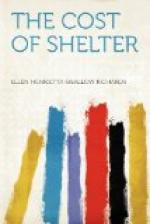Mr. Michael Lane in his “Level of Social Motion” claims that present tendencies are leading to a level of $2000 a year and a family of two children as an average. Mr. Wells claims as a tendency in living conditions the practically automatic and servantless household. In connection with the Mary Lowell Stone Home Economics Exhibit a design of an approach to this kind of a dwelling was asked for in sketch. The accompanying plans were made by a firm who have had not only experience in this kind of domestic building, but who have sympathy with and personal knowledge of similar conditions in widely separated parts of the country.
These sketches are not of an ideal house and not for a given plot of land, but only a hint of what Mrs. Michael Lane “must expect if she attempts to build in the country or suburbs.”
Since these were drawn many changes have come about in costs and in materials available. The architects expressly disclaim the word “model” in relation to them. Mrs. Lane and her two children will do their own work, and therefore steps and stairs must be few, and yet they wish light and air and cleanliness.
The author hopes that her readers will make a study of house-plans, not the cheap ones, but those that will bear the test of time and living in.
The increased cost of shelter should mean both more comfort and greater beauty. If it does not, something is wrong with society.
It appears from all that has been gathered that single houses for a family of five will cost about $5000 to $10,000 for some years to come; that these houses should be so constructed and cared for as to rent for $300 to $400 if the occupant is to keep the grounds in order, to use the house with care, and furnish heat and light.
The question of return on capital invested and of care of exteriors and grounds must be studied most carefully in the light of the new conditions, and a new set of conventions devised by society to meet the various circumstances arising out of them.
This suburban living is the vital point to be attacked, because in cities the matter is already pretty well settled; there is in sight nothing that will greatly change the rule already given, a cost of $1000 per room of about 1200 cubic feet, with the finish and sanitary appliances demanded.
Our family of five must pay for rent $500 to $800 for the smallest quarters they can compress themselves into. Subtracting the cost of heat and light and the car-fares, this may be no more expensive than the suburban house at $300 or $400, but the difference comes in light and air. The upper floors of an isolated skyscraper give more than a country house, but at the expense of other houses in the darkened street.
In the city the question is then not so much one of cost of construction as of a fair arrangement of streets and parks, so as to avoid the loss of light and air for living-places. The single individual may find shelter of a safe and refined sort in all respects except air for $200 to $300 a year in the newer apartment-houses, and two friends to share it may halve this sum. A great need is for as good rooms to be furnished in the suburbs where more light and air may be had.




